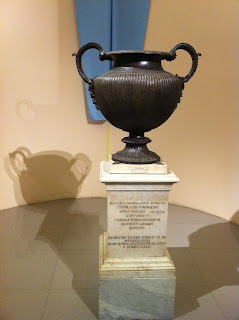Sunday, December 18, 2011 -  Amelia,Cicero,museo archeologico,parricide,Roscius
Amelia,Cicero,museo archeologico,parricide,Roscius
 No comments
No comments
 Amelia,Cicero,museo archeologico,parricide,Roscius
Amelia,Cicero,museo archeologico,parricide,Roscius
 No comments
No comments
Museo Archeologico di Amelia: Pro Sexto Roscio Amerino
This post is part of a series highlighting the collection at the municipal archaeology museum in Amelia. This information is from museum's English placards.
The gens Roscia was one of the most important families of Ameria [the Roman name of Amelia] and was made famous by Cicero's renowned oration defending Sextus Roscius, accused of parricide by two members of his family: Titus Roscius Magnus and Titus Roscius Capito, one of whose descendants may have been mentioned in an inscription in Ameria. Cicero's words tell us about the wealth of his client's father -- thirteen very fertile plots close to the Tiber (Pro Rosc., 20) and about his influential ties with some of Rome's artistocratic families, such at the Metelli and the Scipio. The exploitation of landed property through the work of slaves must have been one of the ways the gens made its fortune. The family also had brickworks, attested to by the seals bearing the family name.
The wealth and reputation of the gens offered some of its members the opportunity to become city magistrates. Well-known family figures became members of the quattuorviri, and in the first half of the 1st century AD one of them -- Titus Roscius Autuma -- donated a thesaurus or container for offers of the faithful at the temples.
Pro Sexto Roscio Amerino
In 80 BC, Cicero defended Sextus Roscius of America, accused by two relatives of murdering his father. The two men responsible for the murder wanted to gain possession of the dead man’s property.
In 80 BC Cicero defended Sextus Roscius, who had been accused of murdering his father. Although this was his first causa publica (criminal case), it brought the orator – who was not even 30 years old at the time – enormous fame. Cicero later proudly recalled his courage in agreeing to defend the man, for in the final phase he had to accuse Chrysogonus, the powerful freedman of the Roman dictator Lucius Cornelius Sulla, but without actually drawing the dictator’s name into the case (De officiis, 14.51).
The accusation of parricide was effectively the last stage of a conspiracy that, as Cicero successfully demonstrated, had been organized by two of Sextus Roscius’ relatives, Titus Roscius Capito and Titus Roscius Magnus, who had murdered the man and wanted to put their hands on his fortune with the help of Chrysogonus. Sextus Roscius – father and son bore the same name – was a wealthy citizen of Ameria whose friends included some of the most important Roman families. One night, he was murdered on his way back from a dinner in Rome, while his son was in Ameria. A few days later, the two conspirators convinced Chrysogonus to put the dead man’s name on the prosciption lists, though they had been closed for some time, in order to cheat the son out of his inheritance. In fact, through this prosciption Sextus Roscius’ property was confiscated and auctioned, only to be bought by Chrysogonus for a pittance compared to its real value, which would then be shared by the three.
In the meantime, in Sulla’s name (though unbeknownst to him) the freedman had received a delegation from the city of Ameria, pleading the cause of Roscius, father and son. Chrysogonus promised to look into the matter, but did nothing. At this point the young Roscius, reduced to poverty and facing a possible death penalty, decided to seek refuge in Rome with his father’s friend Cecilia Metella. While he was there, in order to get rid of him, the two relatives accused him of parricide, a crime punishable with death by drowning.
His father’s powerful friends rallied around him. Realizing the political implications of the trial, they decided not to enter the fray but to hand his defense over to Cicero, whose youth and supposed inexperience would have justified any unwarranted words. In his harsh attack of Chrysogonus, Cicero deftly avoided harming Sulla’s reputation, saying that the dictator could “not have been aware of anything, given that alone he has the entire government in his hands, and is so full of important commitments that he cannot even breathe freely (Pro Rosc., 22).
Sextus Roscius was acquitted of the accusation of parricide.







